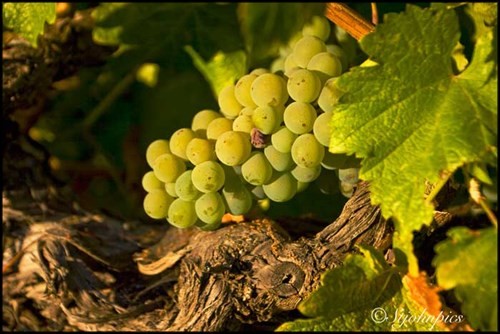Vino In My Dino
Winespeak: Acidity
July 22, 2015 15:39
Posts this month focus on what I call winespeak which are terms that sometimes are obvious in meaning and others are not. Today’s word is acidity.
Acidity is what you would call a building block toward balance in wine. Less of it and the wine becomes flabby, too much and your lips will pucker. Levels of acidity start with grapes and depend on the type of climate where they are grown. Dry Creek Valley, for instance, has warm days bracketed by marine fog. The cooling fog layer rolls in at the end of the day and stays sometimes until mid-morning. The combination both ripens and evens the development in the grapes by using a little refrigerator action in the evenings. Wines from warmer regions develop as well but in a different way. It is the reason we as farmers are concerned if the weather is too hot or too cool and the development isn’t all we hope for during the growing season.
Basically wine has two types of acid: malic acid and lactic acid. Well you start with malic and in order to soften this sharp acidity the wine undergoes a secondary fermentation. The malic acid (think tart green apple) converts to lactic acid (dairy or butter essence) and makes the wine easier to swallow. The process is called malolactic fermentation by the way. All red wines undergo this conversion and some white wines do as well, like Chardonnay and Sauvignon Blanc. It all depends on the style the winemaker would like to achieve. And sometimes the decision to add more acid comes into play, depending on the inclination to higher or lower acidity. This year I am hanging my wine tasting hat on high acid white wines-so refreshing and crisp! A splash of Sauvignon Blanc in my Dino please.
Sauvignon Blanc and a close-to-harvest shot from a previous vintage. We're not there yet but getting very close to picking the 2015 vintage!

Categories
- COVID
- Follow the Vineyard
- Note from Home
- PairItWithPed
- Pandemic
- pedroncelli
- Port
- Postcards from Home
- Pruning
- Seasons in The Cellar
- Tasting Room
- Thanksgiving
- Vintage Notes
- Winemaking
- Women's History Month
Recent posts
-
A Year Filled With Change
-
Pass Me the Ah So
-
Seasons in The Cellar: Scale House
-
Seasons In The Cellar: Summer Edition
-
What is Grape Veraison
Popular tags
- note from home
- Sonoma Classico
- Mother Clone
- Lake Sonoma
- Schotzki
- Sauvignon Blanc
- Cellar Master
- Cookies
- Rosé
- Homecooking
- Oak
- PairitwithPed
- Anniversary
- Heat wave
- Merlot
- Pruning
- Dry Creek Valley
- Easter
- food and wine
- newsletter
- Block 007 Cabernet Sauvignon
- Pedroncelli
- Finding Your Roots
- Holding steady
- Sonoma County
- Pandemic
- Barrels
- cheese
- Harvest 2022
- COVID19
- French Oak
- Four Grapes Port
- OpenThatBottleNight
- Cabernet Sauvignon
- Bushnell Vineyard
- COVID Coffee Chat
- Crop set
- Down to Earth
- Springtime
- Courage Zinfandel
- Recipes
- Habit
- Pantry
- 1974 Cabernet Sauvignon
- Seasons in The Cellar
- American Oak
- cooking with wine
- family
- Follow the Vineyard
- Library Wine





